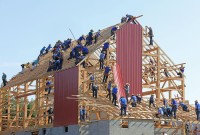- Home
- Business Processes
- Industry Knowledge
- Aerospace Industry
- Automotive Industry
- Banking Domain
- BFSI Industry
- Consumer/ FMCG Industry
- Chemicals Industry
- Engineering & Construction
- Energy Industry
- Education Domain
- Finance Domain
- Hospitality Domain
- Healthcare Industry
- Insurance Domain
- Retail Industry
- Travel and Tourism Domain
- Telecom Industry
- Leadership Skills
- eLearning
- Home
- Domain Knowledge
- Leadership Theories
- Types of Power in Leadership
Types of Power in Leadership
Power is the ability to exercise influence or control over others. Leadership involves authority and it is very important for leaders to understand what type of power they're using. The 5 Types of Power in Leadership are Coercive power, expert power, legitimate power, referent power, and reward power. Authority is the right to command and extract obedience from others. It comes from the organization and it allows the leader to use power.
In the functioning of a leader, the ability to guide the action of others is achieved through his or her authority. Carrying out of these decisions is accomplished because of the power of the leader. You will see the relationship between the authority and power of a leader as we go further to understand various types of power.
1. Legitimate Power:
This power comes to the leader when the organization’s authority is accepted. It comes from the rules of the organization. For e.g. parents, teachers, managers, police, etc. have legitimate power only when their authority is accepted in the positions they hold.
2. Expert Power:
This is the power of knowledge and skill of special kinds that is important in getting the job done. A person’s professional competence or knowledge gives him or her expert power. The credibility increases and he or she can lead other persons to trust the judgments and decisions taken by the leader. A leader may not be an expert in all fields, but one can certainly take the help of experts in particular fields as and when required.
3. Charismatic Power:
This is the power of attraction or devotion, the desire of one person to admire another. A subordinate feels a positive attraction towards a leader by identifying oneself, with the leader, or gets influenced by the leader’s attractive power. This power helps the subordinate to understand and value the leader so much that one understands and acts according to the expectations of the boss or the leader. It helps one to act as one’s own boss, and behave in ways one thinks the boss will want.
4. Reward Power:
This power is the present or potential ability to reward for worthy behavior. The superior or the leader has the power to give tangible rewards such as promotion, office space, time off from work, attractive work assignments, and help to the subordinate. Also, psychological rewards like praise, appreciation, approval, and recognition can be given by the leader or the superior to the subordinate. The subordinate has to believe that the leader has access to higher authorities; therefore, the leader can give rewards. This reward power of the leader can also increase the leader’s charismatic and legitimate power.
5. Coercive Power:
This is the ability to threaten or punish. The leader can give tangible punishment like dismissal, demotion, low rating, less satisfying work assignments, etc. Psychological punishments include criticism, avoidance, disapproval or satirical remarks, etc. on the subordinate. The reward power helps to avoid something undesirable. The self-esteem of the subordinate will increase because of reward power. It also decreases because of punishment or coercive power. Even a subordinate may withdraw or break the rules or become hostile. One may not feel attracted to the charismatic power of the leader and at times may ignore the leader’s legitimate power. Having seen the reasons for differences between the authority and power of the leader, you should know the type of leaders as understood on the basis of their authority and power.
Besides the power aspect one should also account for the following:
Formal Leader:
A formal leader is selected by the organization. For example, a manager is a formal leader by virtue of the authority coming from the organization. He or she influences others to help accomplish the goals of the organization or unit. Such leadership lasts over a long period of time.
Informal Leader:
An informal leader is chosen by the group. Thus, all managers are leaders if their authority is accepted, but not all leaders are managers. Informal leadership is leadership without position and may shift from one person to another. It may last for a brief time. Most people are leaders at one time or the other and they can have an influence on others as defined by the concept of leadership itself.
The ideal leader is the one who can combine formal and informal leadership simultaneously within himself or herself.
Related Links
You May Also Like
-
Productivity is defined not in terms of the number of goods produced, but in terms of value-added per employee. Customers don’t really buy goods and services but in fact, they buy a value - something they value. The future is all about tangible products fulfilling intangible needs. Ideas like this can transform a business and provide them a competitive advantage to thrive in the future.
-
Management theories are the recommended management strategies that enable us to better understand and approach management. Many management frameworks and guidelines were developed during the last four decades.
-
Quantitative Theory of Management
The quantitative management approach is given by the mathematical school that recommends the use of computers and mathematical techniques to solve complex management issues and assist in the managerial decision-making process. Managers observe historical quantitative relationships and use quantitative techniques such as statistics, information models, and computer simulations to improve their decision making.
-
The concept of management refers to the process of planning, organizing, staffing, directing, coordinating, and controlling to achieve organizational goals. It is the management of human, physical, financial, and other valuable resources of the organization in an effective and efficient manner to achieve business objectives.
-
Taylor’s Scientific Management
Taylor’s theory of scientific management aimed at improving economic efficiency and labor productivity. Taylor had a simple view that money motivated people at work. He felt that workers should get a fair day's pay for a fair day's work, and that pay should be linked to the amount produced. He introduced the differential piece rate system, of paying wages to the workers.
-
What are the functions which a leader does to establish as a leader? What are the activities undertaken by them to become great leaders, rather revolutionary leaders? The most important tasks done by a leader in all situations are defining the vision, mission, and goals, leading the team, administrative functions, motivating followers, decision making and conflict resolution, and continuous development.
-
All the teams are dynamic in nature and they take time to come together, they form, develop, and grow in stages, over a period of time. Teams go through five progressive stages: Forming, Storming, Norming, Performing and Adjourning. In this article, we want to introduce you to these stages of team development and certain strategies that you can use to help the team grow and develop in each of these stages.
-
Theory Z also called the "Japanese Management" style is a leadership theory of human motivation focused on organizational behavior, communication, and development. It assumes that employees want to enter into long term partnerships with their employers and peers. Offering stable jobs with an associated focus on the well-being of employees results in increased employee loyalty to the company.
-
Management Principles by Fayol
Henri Fayol (1849-1925), a French industrialist and a prominent European management theorist, developed a general theory of management. Fayol outlined the fourteen principles of management.
-
The development of teams is an ongoing process because the composition of the team may keep on changing. The new members may join and the old members may leave the team. The team members pass through several stages for the development of the team and there has been a lot of research to identify these stages. In this article, we discuss the common theories of team development.
Explore Our Free Training Articles or
Sign Up to Start With Our eLearning Courses

About Us
Learning
© 2023 TechnoFunc, All Rights Reserved










